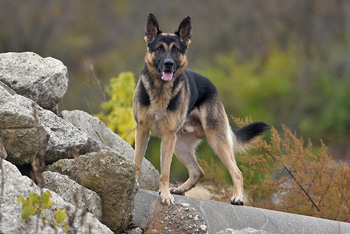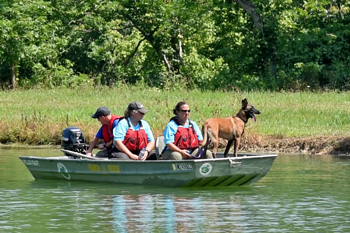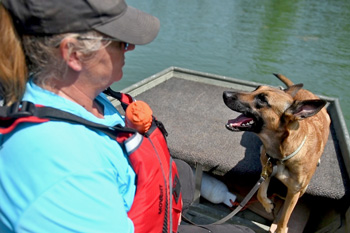Search and Rescue / K-9 Training
Course Descriptions
Effective August 2020
Many of our courses are designed to be taken in sequence, so each level builds on the next. Please give attention to any course prerequisites listed. Any variance from the listed prerequisites must be approved by the IDHS Training section chief.
To register for courses, you must first have a PSID number (K-9s must also have a PSID number). Register for a PSID using the online application. Then, using your PSID and password, log in to the Acadis Portal and browse for IDHS courses. Some prerequisites are offered through FEMA's training website.
Course Legend
Course Prefixes
- K9xxx indicates courses designed for canine handlers and their canines or those interested in how canines are trained and work.
- Note: A dog is not required for a course. Observers welcome.
- SARxxx indicates ground search and search management courses.
Course Numbers
- 100 courses are workshops and foundation training.
- 200 courses are Basic level courses.
- 300 courses are Intermediate level courses.
- 400 courses are Advanced level courses.
- 500 courses are Specialty courses.
K9100 K-9 Learning Theory
Maximum class size: 30 students and 15 K-9s
Course length: 5 hours
This one-day class is for beginner to advanced handlers wanting to better understand how to train their canine partners. The course begins with an interactive lecture (translation: plan to participate!) on canine learning theory. Discover “how” your dog learns! Topics include stages of learning, reinforcement schedules, methods of learning and chaining behaviors. Some class time will be spent in the field putting the learning theories into practice.
K9101 K-9 Skills Day
Maximum class size: 20 students and 15 K-9s
Course length: 8 hours
This one-day workshop is for beginner to advanced handlers wanting to focus on problem areas they are experiencing with their dog. Trainers will be available to assist with your training needs. The primary focus will be on foundation and alerting skills.
K9105 K-9 First Aid
Maximum class size: 20 students, 10 K-9s
Course length: 8 hours
This one-day courses focuses on teaching the student basic K-9 first aid principals. K-9 assessment, what is normal. Bandaging, splinting and other skills needed to render assistance to a K-9 in an emergency. This course is recommended for anyone involved with working with or around K-9s.
K9200 Basic Air Scenting Techniques for K-9s
Maximum class size: 20 students, 10 K-9s
Course length: 8 hours
This one-day class is designed to introduce K-9 teams with techniques used to locate live missing/lost persons. The class is open to those wishing to train their canine to air-scent for live subjects. A combination of classroom lecture and field exercises will provide the student with information and techniques for scent theory, developing a solid alert and drive building, training progression and much more. This is a prerequisite for all intermediate and advanced air scent courses.
PREREQUISITES
- OBEDIENCE & AGILITY (or equivalent)
- ICS 100 (Introduction to Incident Command)
- IS 700 (Introduction to NIMS)
ICS and IS available online at https://training.fema.gov/apply/.
K9300 Intermediate Air Scenting Techniques for K-9s
Maximum class size: 20 students, 10 K-9s
Course length: 16 hours
This two-day course expands on what was learned in the basic level. The handler is taught how to develop a training plan and how to set up problems based on their training objectives. This course is highly recommended for those that assist with training as well as K-9 handlers.
PREREQUISITES
- K9200 BASIC AIR SCENTING TECHNIQUES FOR K-9 TEAMS
K9400 Advanced Air Scenting Search Techniques for K-9s
Maximum class size: 20 students, 10 K-9s
Course length: 16 hours
This two-day class is designed to help experienced K-9 teams with tactics used during the search for missing/lost persons in the wilderness environment. The class is open to air-scent teams. There will also be exercises in land navigation and clue finding. Training is hands-on: scenarios and training exercises are set up based on the dog and handler’s experience level.
PREREQUISITES
- K9300 INTERMEDIATE AIR SCENTING TECHNIQUES FOR K-9 TEAMS
- ICS 200 (Basic Incident Command)
ICS available online at https://training.fema.gov/apply/.
K9210 Basic Land Cadaver/HRD Search Techniques for K-9s
Maximum class size: 20 students, 10 K-9s
Course length: 8 hours
This is a one-day class designed to introduce K-9 teams to techniques used to locate human remains. Students will learn how to handle and store training aids, basic scent theory and proper handling of training material. Field training will consist of imprinting the dog on the cadaver scent and developing a solid alert. This class is applicable to both search dog teams and law enforcement teams. This is a prerequisite for all intermediate and advanced cadaver courses.
PREREQUISITES
- CPR & FIRST AID
- OBEDIENCE & AGILITY (or equivalent)
- ICS 100 (Introduction to Incident Command)
- IS 700 (Introduction to NIMS)
ICS and IS available online at https://training.fema.gov/apply/.
K9310 Intermediate Land Cadaver Search Techniques for K-9s
Maximum class size: 20 students, 10 K-9s
Course length: 8 hours
This two-day course expands on what was learned in the basic level. The handler is taught how to develop a training plan and how to set up problems based on their training objectives.
PREREQUISITES
- K9210 BASIC LAND CADAVER/HRD SEARCH TECHNIQUES FOR K-9s
K9410 Advanced Land Cadaver/HRD Search Techniques for K-9s
Maximum class size: 20 students, 10 K-9s
Course length: 16 hours
This two-day class will help experienced K-9 teams in techniques used to locate human remains. Land cadaver training will cover vehicles, surface, buried and elevated problems. Training will be hands-on with minimal classroom time. Scenarios and training exercises are set up based on the dog and handler’s experience level. K-9s attending should have a solid trained indication.
PREREQUISITES
- K9310 INTERMEDIATE LAND CADAVER SEARCH TECHNIQUES FOR K-9s
- ICS 200 (Basic Incident Command)
ICS available online at https://training.fema.gov/apply/.
K9220 Basic Tracking/Trailing Techniques for K-9s
Maximum class size: 20 students, 10 K-9s
Course length: 8 hours
This one-day class is for those teams wishing to start their dog in trailing and scent discrimination techniques. Field training will consist of how to get started, leash handling and scent theory. This class is applicable to both search dog teams and law enforcement teams. Training will be hands-on with minimal classroom time. Scenarios and training exercises are set up based on the dog and handler’s experience level.
PREREQUISITES
- OBEDIENCE & AGILITY (or equivalent)
- ICS 100 (Introduction to Incident Command)
- IS 700 (Introduction to NIMS)
ICS and IS available online at https://training.fema.gov/apply/.
K9320 Intermediate Tracking/Trailing Search Techniques for K-9s
Maximum class size: 15 students, 10 K-9s
Course length: 16 hours
This two-day class expands on what is learned at the basic level. The handler is taught how to develop a training plan and how to set up problems based on training objectives. Students practice scent discrimination and quarter-mile and half-mile trails.
PREREQUISITES
- K9210 BASIC TRACKING/TRAILING TECHNIQUES FOR K-9s
K9420 Advanced Tracking/Trailing Techniques for K-9s
Maximum class size: 20 students, 10 K-9s
Course length: 16 hours
This two-day class is for those teams with experience in trailing and scent discrimination techniques. Field training will consist of urban, rural and wilderness trails (with single and multiple victims), "line-ups," car trails, negative trails, night-time exercises and more. This class is applicable to both search dog teams and law enforcement teams. Training will be hands-on with minimal classroom time. Scenarios and training exercises are set up based on the dog and handler’s experience level.
PREREQUISITES
- K9320 INTERMEDIATE TRACKING/TRAILING SEARCH TECHNIQUES FOR K-9s
- ICS 200 (Basic Incident Command)
K9500 Water Cadaver/HRD Search Techniques for K-9s
Maximum class size: 20 students, 10 K-9s
Course length: 16 hours
This two-day class is open to those teams that are land cadaver trained. This course will help those new to water search as well as those experienced in water cadaver search. Training will include scent theory, search strategy, boat safety and hands-on training on the water. Scenarios and training exercises are set up based on the dog and handler’s experience level. Water cadaver problems will cover both shoreline and open water searches.
- Note: Your dog must have a solid alert on land in order to participate in water exercises.
PREREQUISITES
- K9210 BASIC LAND CADAVER/HRD SEARCH TECHNIQUES FOR K-9s
- BASIC WATER SAFETY (strongly recommended)
K9555 Basic Building Search Techniques for K-9s
Maximum class size: 20 students, 10 K-9s
Course length: 8 hours
This one-day class is designed to help new as well as experienced K-9 teams with tactics used during the search for missing/lost persons or human remains in buildings. Training is hands-on, and scenarios and training exercises are set up based on the dog and handler’s experience level. K-9s attending should have a solid trained indication.
PREREQUISITES
- K9210 BASIC TRACKING/TRAILING TECHNIQUES FOR K-9s or K9200 BASIC AIR SCENTING TECHNIQUES FOR K-9 TEAMS
K9552 Advanced Building Search Techniques for K-9s
Maximum class size: 20 students, 10 K-9s
Course length: 16 hours
This two-day class expands on what was learned in the Basic course. Emphases will be placed on search tactics, night searching and problem solving. Training is hands-on, and scenarios and training exercises are set up based on the dog and handler’s experience level.
PREREQUISITES
- CPR & FIRST AID
- OBEDIENCE & AGILITY (or equivalent)
- K9210 BASIC LAND CADAVER or K9200 BASIC AIR SCENTING TECHNIQUES FOR K-9 TEAMS
- K9550 BASIC BUILDING SEARCH TECHNIQUES FOR K-9s
- ICS 100 (Introduction to Incident Command)
- IS 700 (Introduction to NIMS)
- ICS 200 (Basic Incident Command)
K9530 Basic Disaster Search Techniques for K-9s
Maximum class size: 20 students, 10 K-9s
Course length: 16 hours
This two-day class is designed to introduce K-9 search teams to the specialized field of disaster response. Students will train in the areas of agility, obedience, alert work and drive building. Students will also have the opportunity to practice their skills on three rubble piles. Training will include live and cadaver/HRD exercises. K-9s attending should have a solid trained indication.
- Note: PPE for rubble search: Handler must wear a helmet, gloves, long pants, long sleeves and safety-toe/steel-shank boots. Knee pads recommended. The Search and Rescue Training Program has a limited number of helmets and knee pads available.
PREREQUISITES
- K9210 BASIC TRACKING/TRAILING TECHNIQUES FOR K-9s or K9200 BASIC AIR SCENTING TECHNIQUES FOR K-9 TEAMS
- PPE for rubble search
K9330 Intermediate Disaster Search Techniques for K-9s
Maximum class size: 20 students, 15 K-9s
Course length: 16 hours
This two-day class expands on what is learned at the basic level. Students will train in the areas of agility, obedience, alert work and directional training. Students will also have the opportunity to practice their skills on rubble piles. Training will include live and cadaver/HRD exercises. K-9s attending should have a solid trained indication.
- Note: PPE for rubble search: Handler must wear a helmet, gloves, long pants, long sleeves and safety-toe/steel-shank boots. Knee pads recommended. The Search and Rescue Training Program has a limited number of helmets and knee pads available.
PREREQUISITES
- K9530 BASIC DISASTER SEARCH TECHNIQUES FOR K-9s
- PPE for rubble search
K9430 Advanced Disaster Search Techniques for K-9s
Maximum class size: 20 students, 10 K-9s
Course length: 16 hours
This two-day class will help experienced K-9 teams in techniques used to locate live subjects or human remains. Disaster training will cover vehicles, surface, buried and elevated problems. Training will be hands-on with minimal classroom time. Scenarios and training exercises are set up based on the dog and handler’s experience level. K-9s attending should have a solid trained indication.
- Note: PPE for rubble search: Handler must wear a helmet, gloves, long pants, long sleeves and safety-toe/steel-shank boots. Knee pads recommended. The Search and Rescue Training Program has a limited number of helmets and knee pads available.
PREREQUISITES
- K9330 INTERMEDIATE DISASTER SEARCH TECHNIQUES FOR K-9s
- HAZARDOUS MATERIALS AWARENESS or IS 005 (Introduction to Hazardous Materials)
- PPE for rubble search
IS available online at https://training.fema.gov/apply/.
K-9 Credentialing
K9600 K-9 Pretest
Maximum class size: 12 students, 12 K-9s
Course length: 8 hours
This is a test to determine that a K-9 team is prepared to meet all requirements for the K-9 Credentialing test. The K-9 and handler will be tested on obedience, agility, socialization and scent verification. There will be a 50-question written exam the handler must pass before being allowed to test with the K-9. Field testing is based on the discipline the K-9 team is working toward credentials in.
- Note: Students must bring proof of prerequisites to the testing site.
PREREQUISITES
- CPR & FIRST AID
- HAZARDOUS MATERIALS AWARENESS
- ICS 100 (Introduction to Incident Command)
- IS 700 (Introduction to NIMS)
- K-9 FIRST AID
- SAR300 GROUND SEARCH OPERATION TECHNIQUES II or NASAR SARTECH II (or equivalent, approved by IDHS SAR manager)
- AWR-110 WMD/TERRORISM AWARENESS
ICS and IS available online at https://training.fema.gov/apply/.
K9650 K-9 Credentialing Test
Maximum class size: 8 students, 8 K-9s
Course length: 8 hours
This is a test to credential K-9 teams in one or more of the following disciplines based on each team's needs and skill sets: article/evidence search, cadaver search (land), cadaver search (water), tracking live, air scent live, disaster live and disaster cadaver. This test will evaluate the ability of a K-9 team to successfully demonstrate the required skills and performance level needed to certify as a consistent and reliable resource during search operations. Please review testing standards; they will be made available to all individuals before testing either electronically on the internet or in printed form.
PREREQUISITES
- K9600 K-9 PRETEST (in discipline that team will test on)
- Pretests required for each Credentialing discipline:
- Cadaver
- Cadaver Search (land)
- Cadaver Search (water)
- Disaster Cadaver
- Live
- Air Scent Live
- Disaster Live
- Article
- Article/Evidence Search
- Tracking
- Tracking Live
- Cadaver
- Pretests required for each Credentialing discipline:
SAR100 Crime Scene Orientation: Blood-Borne Pathogens
Maximum class size: 12 students
Course length: 5 hours
This one-day course is designed to give the student a working knowledge of crime scene procedures, protecting evidence and documentation, and safety of the operator and canine in potential hazardous situations (meth labs, hazmat environments, etc.). Safety in working with and around blood-borne pathogens is covered along with procedures for utilizing personal protective equipment. This course utilizes both lecture and practical sessions.
PREREQUISITES
- ICS 100 (Introduction to Incident Command)
- IS 700 (Introduction to NIMS)
- AWR-110 WMD/TERRORISM AWARENESS (or equivalent)
- HAZARDOUS MATERIALS AWARENESS
ICS and IS available online at https://training.fema.gov/apply/.
SAR101 Search and Rescue Skills Day
Maximum class size: 12 students
Course length: 8 hours
This one-day course is designed to give students an opportunity to perfect their skills in an area selected by the majority of the registered participants. Instructors will be available to assist with basic knots, search techniques, map and compass and other areas where students wish to improve their skills.
PREREQUISITES
- ICS 100 (Introduction to Incident Command)
- IS 700 (Introduction to NIMS)
ICS and IS available online at https://training.fema.gov/apply/.
SAR125 Surface Ice Rescue Awareness
Maximum class size: 25 students
Course length: 8 hours
This one-day course is designed to give the general public and emergency responders information on determining if ice is dangerous or "good ice," preventing and preparing for a possible ice emergency, performing a surface rescue if someone falls through ice, determining the last known location if unable to reach a victim and preparing and helping arriving emergency response personnel, and understanding hypothermia prevention, signs, symptoms, self-survival and treatment.
The intent of the course for emergency responders is to provide information so they can return to their local communities and deliver a similar public service program to locals living near bodies of water. Students should bring appropriate cold-weather gear. The afternoon session will be outdoors with hands-on practice with reaching and throwing devices.
PREREQUISITES
- ICS 100 (Introduction to Incident Command)
ICS available online at https://training.fema.gov/apply/.
SAR200 Ground Search Awareness Techniques III
Maximum class size: 12 students
Course length: 16 hours
This two-day course is designed to introduce the student to the specialized training required for ground search operations. The knowledge and skills topics covered in this awareness course include: Introduction to SAR, SAR management, map and compass, communications, search theory, lost person behavior, SAR resources, clue consciousness, ground search tactics, search operational process and several mock search exercises. This course is based on NASAR standards for searching rural and wilderness environments.
Note: This is not a classroom-only course. Because there are field exercises included, students must come equipped with personal PPE and clothing for any weather, and they should be prepared for physical exertion in the field. All personnel involved in SAR should attend.
PREREQUISITES
- CPR & FIRST AID
- ICS 100 (Introduction to Incident Command)
- IS 700 (Introduction to NIMS)
ICS and IS available online at https://training.fema.gov/apply/.
SAR205 Basic Emergency Rope Techniques for SAR Personnel
Maximum class size: 12 students
Course length: 8 hours
This one-day course is designed to introduce the student to the basics of life safety rope and webbing, rope rescue hardware and personal equipment, knots, anchors, anchoring systems, low-angle rappelling, edge protection and belay systems. Instructors will teach basic knots including but not limited to the figure eight, family of eights, clove hitch, double fisherman, water knot using one-inch tubular webbing and an improvised Swiss seat.
PREREQUISITES
- CPR & FIRST AID
SAR300 Ground Search Operation Techniques II
Maximum class size: 15 students
Course length: 16 hours
This two-day course is designed to expand upon the Awareness course and provides hands-on training for field personnel to effectively participate in ground search operations as a crew member. The knowledge and skills topics covered in this operations course include: SAR management at the crew member level, survival, improvement, self-sufficiency, outdoor environmental hazards, outdoor clothing, personal equipment, backcountry travel skills, land navigation, ground crew search techniques and tactics, tracking lost/missing persons, handling evidence and crime-scene protection, basic knots for SAR, non-technical litter evacuation and an outdoor mock search exercise. This course is based on NASAR standards for searching rural and wilderness environments.
Note: Because several field exercises are included in this course, the student must come equipped for any weather and be prepared for physical exertion in the field.
PREREQUISITES
- SAR200 GROUND SEARCH AWARENESS TECHNIQUES III
- ICS 200 (Basic Incident Command)
- AWR-110 WMD/TERRORISM AWARENESS (or equivalent)
- HAZARDOUS MATERIALS AWARENESS
ICS available online at https://training.fema.gov/apply/.
SAR400 Ground Search Technician Techniques I
Maximum class size: 12 students
Course length: 16 hours
This two-day course expands upon the Operation course and provides hands-on training for field personnel to effectively participate in ground search operations as a crew member. The knowledge and skills topics covered in this technician course include: SAR management at the crew level, survival, self-sufficiency, outdoor environmental hazards, outdoor clothing, personal equipment, backcountry travel skills, land navigation, ground crew search techniques and tactics, tracking lost/missing persons, handling evidence and crime-scene protection, basic knots for SAR, non-technical litter evacuation and an outdoor mock search exercise. This course is based on NASAR standards for searching rural and wilderness environments.
Note: Because several field exercises are included in this course, the student must come equipped for any weather and be prepared for physical exertion in the field.
PREREQUISITES
- SAR200 GROUND SEARCH AWARENESS TECHNIQUES III
- ICS 200 (Basic Incident Command)
- AWR-110 WMD/TERRORISM AWARENESS (or equivalent)
- HAZARDOUS MATERIALS AWARENESS
ICS available online at https://training.fema.gov/apply/.
SAR250 Search and Rescue Management: Awareness
Maximum class size: 20 students
Course length: 16 hours
This two-day course is designed to introduce students to the specialized training required for management of search and rescue operations. The knowledge and skills topics covered in this awareness course include: introduction to search management, leadership of management staff, common search management mistakes, operational preplanning, introduction to search theory, initial response to a SAR incident, managing the first operational period, introduction to search planning, introduction to search operations, transition into the second operational period and a tabletop mock search exercise.
PREREQUISITES
- SAR200 GROUND SEARCH AWARENESS III
- ICS 100 (Introduction to Incident Command)
- IS 700 (Introduction to NIMS)
- ICS 200 (Basic Incident Command)
- AWR-110 WMD/TERRORISM AWARENESS (or equivalent)
- HAZARDOUS MATERIALS AWARENESS
ICS and IS available online at https://training.fema.gov/apply/.
SAR500 Tracking & Signcutting
Maximum class size: 12 students
Course length: 16 hours
This two-day class will introduce the student to the art of finding, identifying and following the evidence of a person’s presence and their direction of travel. Tracking provides the search and rescue responder with invaluable information that may otherwise go unseen. Tracks and clues are numerous, but being able to locate them takes the proper training. This course will help the student to become “track aware” by introducing equipment needed and how it is used, responsibilities of tracking teams, fundamental principals of tracking, the effects of the environment on tracks and identifying various tracks and clues through both classroom and field exercises.
PREREQUISITES
- SAR300 GROUND SEARCH OPERATION TECHNIQUES II
- ICS 100 (Introduction to Incident Command)
- IS 700 (Introduction to NIMS)
ICS and IS available online at https://training.fema.gov/apply/.
SAR520 Land Navigation: Operations
Maximum class size: 12 students
Course length: 16 hours
Students will review basic map skills before moving on to practice intermediate and advanced techniques. Map and compass are used together in challenging land navigation field exercises. At the end of this course, students will be able to safely and accurately navigate using a variety of maps and systems. This course is designed for SAR crews, police, wildfire personnel, wilderness EMTs, naturalists, storm spotters and more.
Topics include: accurate compass bearings, determining line of travel, bearings and back azimuths, determining distances on the map and on the ground, reading topographical maps, identifying common land features, plotting location with UTM coordinates and GPS.
Note: Please be prepared to stay late. Course includes day and night exercises.
PREREQUISITES
- CPR & FIRST AID
- SAR200 GROUND SEARCH AWARENESS III (or St. Vincent Wilderness Medical Course)
- ICS 100 (Introduction to Incident Command)
- IS 700 (Introduction to NIMS)
ICS and IS available online at https://training.fema.gov/apply/.
SAR530 Lost Person Behavior
Maximum class size: 20 students
Course length: 8 hours
During this one-day course, students will be introduced to the latest information and research regarding the lost person behavioral profiles. Particular emphasis is placed on the newer research concerning people with Alzheimer's, despondency, intellectual disabilities or psychosis and abducted children, cross-country skiers and mountain bikers. Students will learn important background information, its implications for search and rescue, how to establish a prevention program, search statistics, behavioral statistics and how to plan a search for each subject type. The participants will have the opportunity to work several practical scenarios.
PREREQUISITES
- ICS 100 (Introduction to Incident Command)
- IS 700 (Introduction to NIMS)
- Active position in which this information will be implemented, such as law enforcement, firefighting, emergency management or search and rescue.
ICS and IS available online at https://training.fema.gov/apply/.





